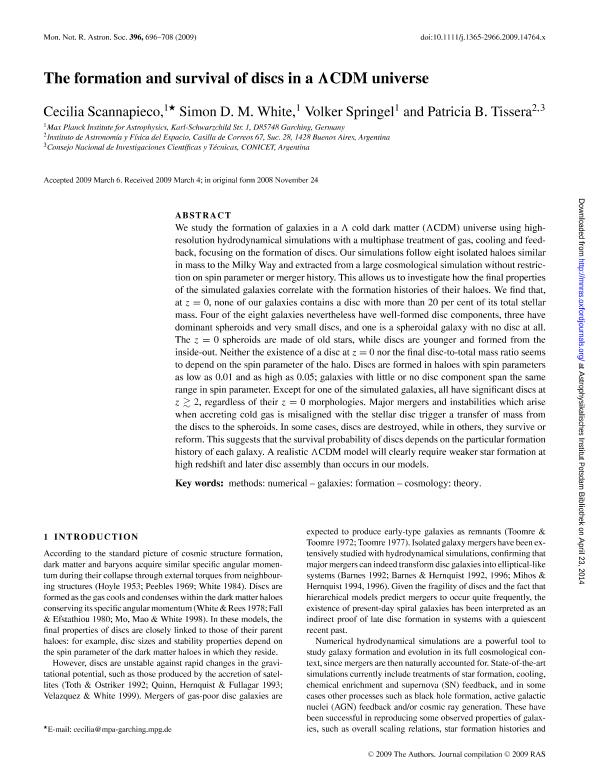Mostrar el registro sencillo del ítem
dc.contributor.author
Scannapieco, Cecilia

dc.contributor.author
White, Simon D. M.
dc.contributor.author
Springel, Volker
dc.contributor.author
Tissera, Patricia Beatriz

dc.date.available
2017-08-01T18:26:31Z
dc.date.issued
2009-06
dc.identifier.citation
Scannapieco, Cecilia; White, Simon D. M.; Springel, Volker; Tissera, Patricia Beatriz; The formation and survival of discs in a Lambda-CDM universe; Wiley Blackwell Publishing, Inc; Monthly Notices of the Royal Astronomical Society; 396; 2; 6-2009; 696-708
dc.identifier.issn
0035-8711
dc.identifier.uri
http://hdl.handle.net/11336/21748
dc.description.abstract
We study the formation of galaxies in a cold dark matter (CDM) universe using highresolution hydrodynamical simulations with a multiphase treatment of gas, cooling and feedback, focusing on the formation of discs. Our simulations follow eight isolated haloes similar in mass to the Milky Way and extracted from a large cosmological simulation without restriction on spin parameter or merger history. This allows us to investigate how the final properties of the simulated galaxies correlate with the formation histories of their haloes. We find that, at z = 0, none of our galaxies contains a disc with more than 20 per cent of its total stellar mass. Four of the eight galaxies nevertheless have well-formed disc components, three have dominant spheroids and very small discs, and one is a spheroidal galaxy with no disc at all. The z = 0 spheroids are made of old stars, while discs are younger and formed from the inside-out. Neither the existence of a disc at z = 0 nor the final disc-to-total mass ratio seems to depend on the spin parameter of the halo. Discs are formed in haloes with spin parameters as low as 0.01 and as high as 0.05; galaxies with little or no disc component span the same range in spin parameter. Except for one of the simulated galaxies, all have significant discs at z 2, regardless of their z = 0 morphologies. Major mergers and instabilities which arise when accreting cold gas is misaligned with the stellar disc trigger a transfer of mass from
the discs to the spheroids. In some cases, discs are destroyed, while in others, they survive or reform. This suggests that the survival probability of discs depends on the particular formation history of each galaxy. A realistic CDM model will clearly require weaker star formation at high redshift and later disc assembly than occurs in our models.
dc.format
application/pdf
dc.language.iso
eng
dc.publisher
Wiley Blackwell Publishing, Inc

dc.rights
info:eu-repo/semantics/openAccess
dc.rights.uri
https://creativecommons.org/licenses/by-nc-sa/2.5/ar/
dc.subject
Methods:Numerical
dc.subject
Galaxies:Formation
dc.subject
Cosmology:Theory
dc.subject.classification
Astronomía

dc.subject.classification
Ciencias Físicas

dc.subject.classification
CIENCIAS NATURALES Y EXACTAS

dc.title
The formation and survival of discs in a Lambda-CDM universe
dc.type
info:eu-repo/semantics/article
dc.type
info:ar-repo/semantics/artículo
dc.type
info:eu-repo/semantics/publishedVersion
dc.date.updated
2017-07-28T15:05:15Z
dc.journal.volume
396
dc.journal.number
2
dc.journal.pagination
696-708
dc.journal.pais
Reino Unido

dc.journal.ciudad
Londres
dc.description.fil
Fil: Scannapieco, Cecilia. Gobierno de la Republica Federal de Alemania. Max Planck Institut Fur Astrophysik; Alemania. Consejo Nacional de Investigaciónes Científicas y Técnicas. Oficina de Coordinación Administrativa Ciudad Universitaria. Instituto de Astronomía y Física del Espacio. - Universidad de Buenos Aires. Facultad de Ciencias Exactas y Naturales. Instituto de Astronomía y Física del Espacio; Argentina
dc.description.fil
Fil: White, Simon D. M.. Gobierno de la Republica Federal de Alemania. Max Planck Institut Fur Astrophysik; Alemania
dc.description.fil
Fil: Springel, Volker. Gobierno de la Republica Federal de Alemania. Max Planck Institut Fur Astrophysik; Alemania
dc.description.fil
Fil: Tissera, Patricia Beatriz. Consejo Nacional de Investigaciónes Científicas y Técnicas. Oficina de Coordinación Administrativa Ciudad Universitaria. Instituto de Astronomía y Física del Espacio. - Universidad de Buenos Aires. Facultad de Ciencias Exactas y Naturales. Instituto de Astronomía y Física del Espacio; Argentina
dc.journal.title
Monthly Notices of the Royal Astronomical Society

dc.relation.alternativeid
info:eu-repo/semantics/altIdentifier/url/http://mnras.oxfordjournals.org/content/396/2/696
dc.relation.alternativeid
info:eu-repo/semantics/altIdentifier/doi/http://dx.doi.org/10.1111/j.1365-2966.2009.14764.x
dc.relation.alternativeid
info:eu-repo/semantics/altIdentifier/url/http://onlinelibrary.wiley.com/doi/10.1111/j.1365-2966.2009.14764.x/abstract
dc.relation.alternativeid
info:eu-repo/semantics/altIdentifier/url/https://arxiv.org/abs/0812.0976
Archivos asociados
